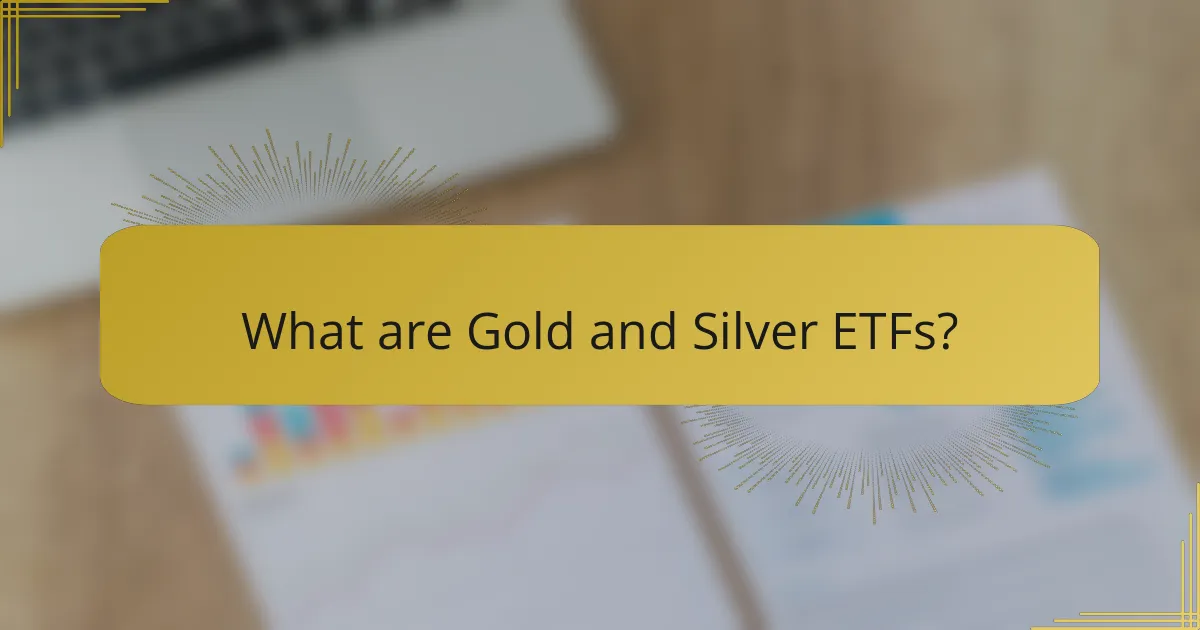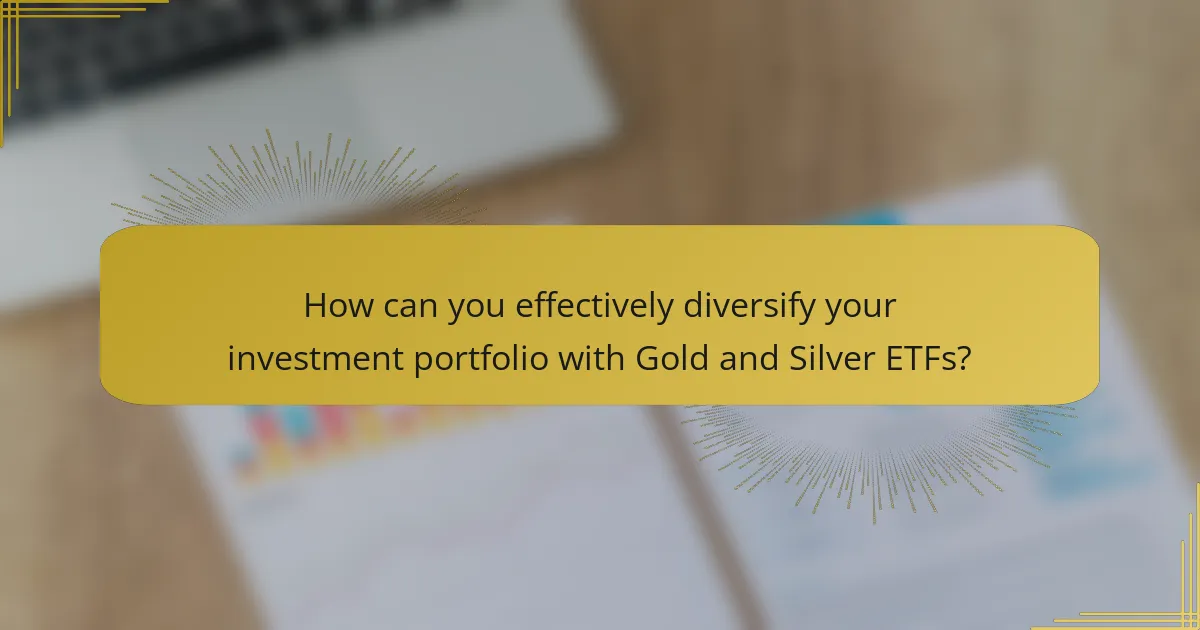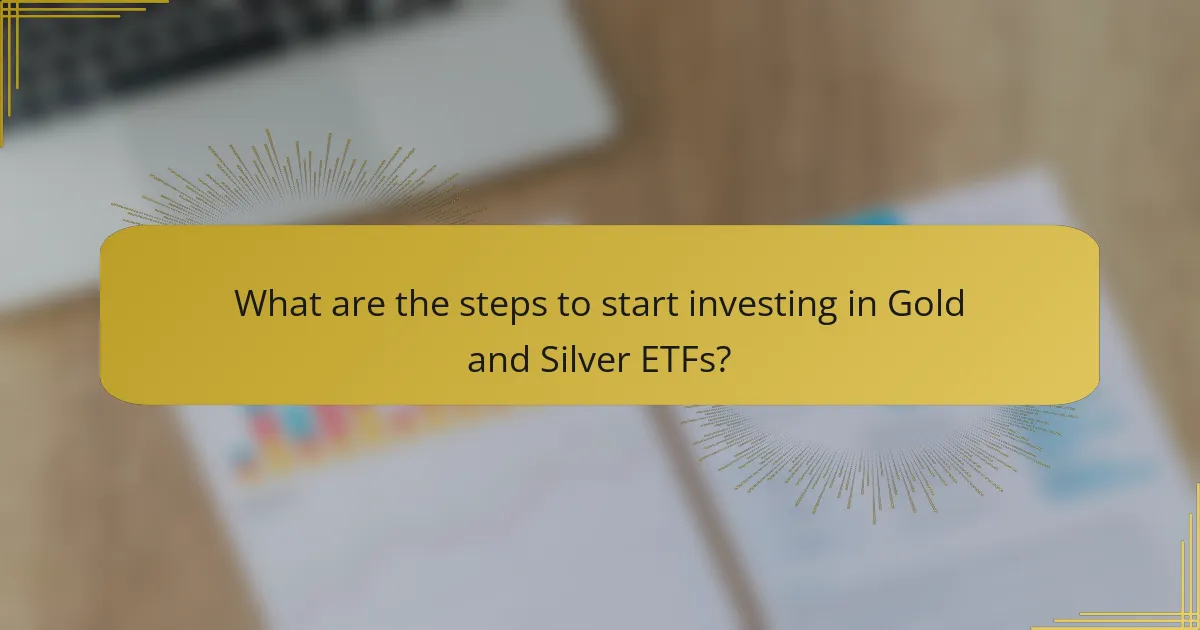Gold and Silver ETFs are exchange-traded funds that provide investors with exposure to the price movements of gold and silver assets without the need to own physical bullion. These ETFs are traded on stock exchanges and can enhance portfolio diversification by serving as a hedge against inflation and market volatility. The article outlines the benefits of investing in Gold and Silver ETFs, including their historical performance during economic downturns and the demand for silver due to its industrial applications. Additionally, it provides a step-by-step guide on how to start investing in these ETFs, from researching available options to placing an order through a brokerage account.

What are Gold and Silver ETFs?
Gold and Silver ETFs are exchange-traded funds that invest in gold and silver assets. They allow investors to gain exposure to the price movements of these precious metals without needing to own physical bullion. Gold ETFs typically hold physical gold bullion or gold-related securities. Silver ETFs operate similarly, focusing on silver assets. Both types of ETFs are traded on stock exchanges, making them easily accessible to investors. According to the World Gold Council, gold ETFs saw significant inflows in 2020, highlighting their popularity as investment vehicles.
How do Gold and Silver ETFs function in the investment market?
Gold and Silver ETFs function as investment vehicles that track the price of gold and silver. They allow investors to gain exposure to precious metals without physically owning them. These ETFs hold physical bullion or futures contracts. They are traded on stock exchanges like regular stocks. Investors buy shares in the ETF, which represent a portion of the underlying assets. The value of the ETF shares fluctuates with the market price of gold or silver. According to the World Gold Council, gold ETFs saw a record inflow of $39 billion in 2020, highlighting their popularity. Silver ETFs also experienced significant growth, with assets surpassing $20 billion in the same year.
What are the key components of Gold and Silver ETFs?
Gold and Silver ETFs primarily consist of underlying physical metals, futures contracts, and mining stocks. These funds aim to track the price movements of gold and silver. The physical metals provide direct exposure to commodity prices. Futures contracts allow for speculation on future prices without holding the physical asset. Mining stocks represent shares in companies that extract these metals, offering leverage to price movements. Additionally, management fees and expense ratios are key financial components affecting investor returns. According to the World Gold Council, gold ETFs held over 3,800 tons of gold by 2021, demonstrating their significant role in the market.
How do Gold and Silver ETFs differ from traditional investments?
Gold and Silver ETFs differ from traditional investments primarily in their structure and asset backing. ETFs are traded on stock exchanges like stocks. They represent a share of a fund that holds physical gold or silver. Traditional investments often involve direct ownership of assets, such as stocks or bonds.
ETFs provide liquidity and ease of trading, allowing investors to buy and sell throughout the trading day. In contrast, traditional investments may require more complex transactions and longer settlement periods. Gold and Silver ETFs can also offer lower fees compared to managing physical assets.
Moreover, ETFs allow for instant diversification across various precious metals without the need for storage or security concerns associated with physical holdings. This makes them a more accessible option for investors looking to gain exposure to gold and silver markets.
What are the advantages of investing in Gold and Silver ETFs?
Investing in Gold and Silver ETFs offers several advantages. Firstly, they provide easy access to precious metals without the need for physical storage. Investors can buy and sell these ETFs like stocks on major exchanges. This liquidity makes it convenient to enter and exit positions quickly. Additionally, Gold and Silver ETFs often have lower expense ratios compared to purchasing physical gold or silver.
They also allow for diversification within an investment portfolio. Precious metals tend to have a low correlation with traditional assets like stocks and bonds. This characteristic can help reduce overall portfolio risk. Furthermore, Gold and Silver ETFs can serve as a hedge against inflation and currency fluctuations. Historical data shows that during economic downturns, precious metals often retain or increase their value.
How do Gold and Silver ETFs provide a hedge against inflation?
Gold and Silver ETFs provide a hedge against inflation by tracking the prices of these precious metals. When inflation rises, the purchasing power of currency typically declines. Gold and silver have historically maintained their value during inflationary periods. For instance, during the 1970s, gold prices surged as inflation escalated, demonstrating their protective qualities. Additionally, investors often flock to gold and silver as safe-haven assets during economic uncertainty. This increased demand can drive up prices, further enhancing their inflation-hedging ability. Thus, Gold and Silver ETFs serve as a strategic investment during inflationary times.
What liquidity benefits do Gold and Silver ETFs offer to investors?
Gold and Silver ETFs provide high liquidity benefits to investors. They can be easily bought and sold on major stock exchanges. This allows for quick entry and exit from positions. Investors can trade these ETFs throughout the trading day. The trading volume of Gold and Silver ETFs is often substantial. This high volume reduces the bid-ask spread, making transactions more cost-effective. Additionally, these ETFs can be converted into physical gold or silver if desired. This feature adds another layer of liquidity for investors. Overall, the liquidity of Gold and Silver ETFs enhances their appeal as a flexible investment option.

How can you effectively diversify your investment portfolio with Gold and Silver ETFs?
Investing in Gold and Silver ETFs can effectively diversify your portfolio by providing exposure to precious metals. These ETFs track the price of gold and silver, offering a hedge against inflation and market volatility. Gold and silver often move inversely to stock market trends. This means when stocks decline, precious metals may rise, balancing overall portfolio risk. Historical data shows that gold has increased in value during economic downturns, making it a reliable asset. Additionally, silver has industrial applications, which can drive demand in growing sectors. By allocating a portion of your investments to these ETFs, you can enhance your portfolio’s resilience and potential for returns.
What strategies can be employed for diversification using Gold and Silver ETFs?
Investors can employ several strategies for diversification using Gold and Silver ETFs. One strategy is to allocate a percentage of the portfolio to these ETFs. This can reduce overall risk. Historical data shows that gold often moves inversely to stocks. This inverse relationship can stabilize a portfolio during market downturns.
Another strategy is to combine Gold and Silver ETFs in a balanced manner. This approach can capture the unique benefits of both metals. Gold typically serves as a safe haven, while silver has industrial applications. Diversifying between the two can enhance returns.
Additionally, investors can use dollar-cost averaging. This involves regularly investing a fixed amount in Gold and Silver ETFs. This method can mitigate the impact of market volatility over time. It allows investors to buy more shares when prices are low and fewer when prices are high.
Finally, monitoring economic indicators can inform investment decisions. Factors such as inflation rates and currency strength can influence gold and silver prices. Adjusting allocations based on these indicators can optimize diversification.
How much of your portfolio should be allocated to Gold and Silver ETFs?
A common recommendation is to allocate 5% to 10% of your portfolio to Gold and Silver ETFs. This allocation helps in diversifying investments and hedging against inflation. Historical data suggests that gold has a low correlation with stocks and bonds. This characteristic makes it a valuable asset during market downturns. Silver also provides industrial demand benefits, enhancing its investment appeal. Experts often cite that a balanced approach minimizes risk while maximizing potential returns.
What other assets should be combined with Gold and Silver ETFs for effective diversification?
Real estate investment trusts (REITs) should be combined with Gold and Silver ETFs for effective diversification. REITs provide exposure to the real estate market, which often behaves differently than precious metals. This can reduce overall portfolio volatility. Additionally, equities in sectors like technology or healthcare can enhance growth potential. Bonds, particularly government bonds, offer stability and income. Commodities beyond precious metals, such as agricultural products, can further diversify risk. Historical data shows that portfolios including these assets tend to perform better across various market conditions.
What are the risks associated with investing in Gold and Silver ETFs?
Investing in Gold and Silver ETFs carries several risks. Market volatility can significantly affect the prices of gold and silver. Economic downturns may lead to decreased demand for these metals. Currency fluctuations can impact the value of ETFs, especially if they are traded in foreign currencies. Additionally, management fees and expenses can reduce overall returns. Liquidity risk exists if there are not enough buyers or sellers in the market. Regulatory changes may also affect the operations of ETFs. Lastly, geopolitical events can lead to sudden price changes in precious metals.
How can market volatility impact the value of Gold and Silver ETFs?
Market volatility can significantly impact the value of Gold and Silver ETFs. During periods of high volatility, investors often seek safe-haven assets. Gold and silver are traditionally viewed as such safe havens. Increased demand for these metals typically drives up the prices of Gold and Silver ETFs. Conversely, when market conditions stabilize, demand may decrease. This can lead to a decline in the value of these ETFs. Historical data shows that during market downturns, gold prices often rise while equities fall. For instance, in 2008, gold prices surged as stock markets plummeted. Thus, market volatility directly influences investor behavior and, consequently, the value of Gold and Silver ETFs.
What are the potential fees and costs involved with Gold and Silver ETFs?
Gold and Silver ETFs typically involve management fees, trading commissions, and potential expense ratios. Management fees are charged by the fund manager for overseeing the ETF. These fees generally range from 0.2% to 1% of the fund’s assets annually. Trading commissions apply when buying or selling ETF shares on a stock exchange. These commissions vary based on the brokerage used. Expense ratios represent the total annual cost of operating the fund, including management fees and other operational expenses. For Gold and Silver ETFs, expense ratios can range from 0.5% to 1.5%. Additionally, investors may incur tax implications depending on the capital gains from ETF sales. Understanding these costs is essential for evaluating the overall investment in Gold and Silver ETFs.

What are the steps to start investing in Gold and Silver ETFs?
To start investing in Gold and Silver ETFs, follow these steps. First, research different Gold and Silver ETFs available in the market. Look for funds that track the price of gold or silver closely. Next, open a brokerage account if you do not have one. Choose a brokerage that offers access to ETFs and low fees. After that, fund your brokerage account with the amount you plan to invest. Then, use the brokerage platform to search for the specific Gold or Silver ETF you want to buy. Review the ETF’s details, including its performance and expense ratio. Finally, place an order to purchase the ETF shares. Confirm your order and monitor your investment regularly. According to the World Gold Council, Gold ETFs saw significant growth in 2020, indicating their popularity among investors.
How do you choose the right Gold and Silver ETFs for your investment goals?
To choose the right Gold and Silver ETFs for your investment goals, assess your financial objectives and risk tolerance. Identify whether you seek long-term growth or short-term gains. Research the ETF’s holdings to ensure it tracks the desired gold and silver markets effectively. Examine the expense ratio, as lower costs can enhance your returns over time. Check the ETF’s performance history against benchmarks, which provides insights into its reliability. Evaluate the liquidity of the ETF to ensure ease of buying and selling. Consider the tax implications of investing in these ETFs, as they can vary based on your location. Finally, consult financial advisors or resources to align your choices with broader investment strategies.
What factors should you consider when evaluating different Gold and Silver ETFs?
When evaluating different Gold and Silver ETFs, consider the fund’s expense ratio. A lower expense ratio can lead to higher net returns. Assess the fund’s liquidity to ensure you can buy or sell shares easily. Look at the tracking error, which indicates how closely the ETF follows the price of the underlying assets. Review the fund’s holdings to confirm the quality and quantity of gold and silver it contains. Check the fund’s performance history to understand how it has performed in various market conditions. Analyze the issuer’s reputation and management experience in the precious metals sector. Finally, consider tax implications, as different ETFs may have varying tax treatments.
How can you research the performance history of Gold and Silver ETFs?
To research the performance history of Gold and Silver ETFs, start by visiting financial news websites. Websites like Yahoo Finance and Bloomberg provide historical data on ETF performance. You can also check the official websites of the ETFs for detailed performance charts.
Financial platforms such as Morningstar offer comprehensive analysis and historical performance metrics. Additionally, brokerage platforms often provide tools to analyze ETF performance over different time periods.
Reviewing annual reports and fact sheets can also provide insights into past performance. Historical price data can be found on market data aggregators like Google Finance.
For specific performance metrics, consider looking at the ETF’s expense ratio and tracking error. These factors can influence overall performance and are often reported alongside historical data.
What best practices should you follow when investing in Gold and Silver ETFs?
Investing in Gold and Silver ETFs requires strategic best practices. First, research the ETFs thoroughly to understand their underlying assets. Look for funds with low expense ratios, as higher costs can erode returns. Diversify your holdings by choosing multiple ETFs that track different gold and silver indices. Monitor market trends and economic indicators that influence precious metal prices. Set clear investment goals and risk tolerance levels before investing. Consider the liquidity of the ETFs, ensuring you can buy and sell easily. Lastly, review your portfolio regularly to adjust your investments based on performance and market conditions.
How can you monitor and adjust your Gold and Silver ETF investments over time?
To monitor and adjust your Gold and Silver ETF investments over time, regularly review market trends and economic indicators. Use financial news platforms and market analysis tools to stay informed. Track the performance of your ETFs against benchmarks like gold and silver prices. Set specific investment goals and adjust your portfolio based on performance relative to these goals. Rebalance your portfolio periodically to maintain your desired asset allocation. Assess factors that influence gold and silver prices, such as inflation rates and geopolitical events. Utilize tools like alerts and portfolio tracking apps for real-time updates. Historical data shows that active monitoring can lead to better investment outcomes.
What common mistakes should be avoided when investing in Gold and Silver ETFs?
Investors should avoid several common mistakes when investing in Gold and Silver ETFs. One mistake is not understanding the underlying assets. Gold and Silver ETFs may not hold physical metals. Instead, they may track the price of gold and silver. This can lead to unexpected performance discrepancies.
Another mistake is neglecting to analyze fees. High expense ratios can erode investment returns over time. Investors should compare fees across different ETFs to make informed choices.
Additionally, failing to consider market conditions is a common error. Precious metals can be volatile and influenced by economic factors. Investors should stay informed about market trends and adjust their strategies accordingly.
Finally, not having a clear investment strategy can lead to poor decision-making. Setting specific goals and timelines is crucial. This helps in maintaining focus and discipline in the investment process.
Gold and Silver ETFs are investment vehicles that allow investors to gain exposure to precious metals without owning physical bullion. This article outlines how these ETFs function, their key components, and the advantages they offer, such as liquidity, diversification, and inflation hedging. It also discusses strategies for effectively incorporating Gold and Silver ETFs into an investment portfolio, the risks associated with these investments, and best practices for monitoring and adjusting holdings over time. Additionally, the article provides insights into selecting the right ETFs based on individual investment goals and market conditions.